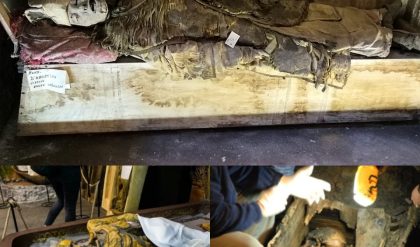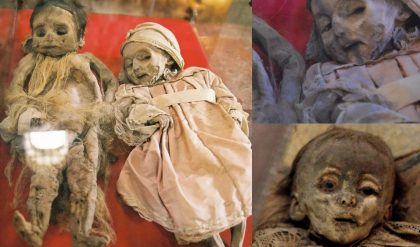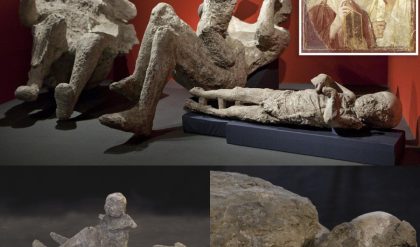As part of the restoration works of the Gothic cloister of the Royal Monastery of Santes Creus currently underway in Catalonia, archaeologists have uncovered the ‘totally unexpected’ intact remains of 8 skeletal bodies! The ‘exceptional discovery’ has been dated to the 13th and 14th centuries, with the intact sarcophagi corresponding to members of medieval Catalan nobility. Based on existing documentation, the team deduce that the tombs had already been looted and raided.
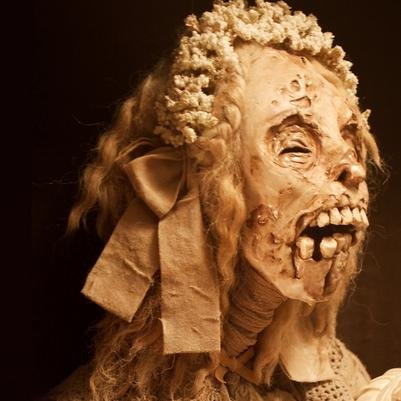
Bloodline in the Age of Spanish Feudalism: The Royal Families of Catalonia
The royals were buried in Santes Creus following King James II (also known as James the Just or James of Aragon) and his second wife Blanca d’Anjou, to turn the monastery into ‘a pantheon of Catalan royalty’ according to a press release by the Catalan Ministry of Culture. James was the King of Aragon and Valencia and Count of Barcelona from 1291 to 1327, amongst other titles held during his lifetime.

The restoration of the Santes Creus Monastery has revealed relics related to Catalan medieval history and the Cistercian order. (Department of Culture of the Generalitat of Catalonia)
Last April, archaeologists began restoration efforts at the Royal Monastery of Santes Creus. Their objectives included waterproofing the monastery’s roof and refurbishing its renowned tombs. In the process, they uncovered six stone sarcophagi embedded within one of the walls. This chamber, identified as the cloister, is renowned for containing the tombs of numerous noble families dating back to the 1300s, with imposing and intricately crafted stone coffins.
“In principle, there shouldn’t be human remains in such good condition inside the sarcophagi, because they should have been looted,” archaeologist Josep Maria Vila told Catalan News.
“In no other site we have excavated have we found so many remains in such good condition.” Instead, the burials were as the monks had left it.”
The sarcophagi within the monastery are adorned with heraldic symbols, aiding in the identification of the nobles entombed within as members of the Cervelló, Cervera, Queralt, Puigvert, and Montcada families.
Samples of human tissue and textile fabric have been carefully extracted from these tombs. Upon analysis, these samples are expected to yield invaluable insights into various aspects of the individuals’ lives – identities, dietary habits, potential ailments they suffered from, living conditions, burial practices and rituals.

The remains found were in excellent states of preservation. (Department of Culture of the Generalitat of Catalonia)
The Royal Monastery of Santes Creus: From Cistercian Abbey to Familial Mausoleum
The Royal Monastery of Santes Creus, a 12th-century Cistercian abbey situated in the Catalan province of Tarragona, Spain, holds immense historical and architectural significance. Its origins trace back to approximately 1160 when the Montcada and Cervelló lineages, supported by Count Ramon Berenguer IV, donated land to a group of monks from the French abbey of the Grand Selva. The intention was for the monastery to also serve as a familial mausoleum, reports National Geographic History.
Nestled along the banks of the Gaià river amidst lush surroundings, the monastery thrived due to its ample water supply, expansive land, and picturesque setting. It evolved around an existing church, eventually becoming one of the most prominent and influential establishments in the Crown of Aragon until its abandonment in 1835.
Throughout the 13th and 14th centuries, Santes Creus became the final resting place for various nobles, a decision sanctioned by King James II “the Just” and his consort Blanche of Anjou, as mentioned above. It would end up housing individuals who held significant roles in feudal society during the medieval era.
Around 1774, the Royal Monastery of Santes Creus saw the commencement of definitive constructions, particularly around the chapel of the Holy Trinity. The architectural plan followed the typical layout of Cistercian monasteries, reflecting the austere style synonymous with the prevailing order.
During this initial phase of construction, several key structures were erected, including a cloister, the church, the sacristy, a chapter room, and the parlor. Above these spaces, the monks’ living quarters were completed as early as the 13th century.

The royal remains were predominantly found the north gallery of the monastery’s Gothic cloister. (Department of Culture of the Generalitat of Catalonia)
In 1313, a new cloister project commenced, deviating from the traditional Cistercian style by incorporating abundant decorative elements more reminiscent of the Gothic style prevalent in the Crown of Aragon. Subsequent periods witnessed further modifications and additions to this medieval masterpiece, blending styles from different epochs – including the Romanesque façade juxtaposed with Gothic stained glass, defensive structures dating back to the late 14th century, and beautifully crafted altarpieces from the 17th century that adorn the interior.
Following its abandonment in 1835, the monastery underwent restoration efforts and was declared a national monument in 1921, subsequently falling under the ownership of the Generalitat de Catalunya.
During the same period in Catalonia, three Cistercian monasteries held great significance: Poblet, Vallbona de les Monges, and Santes Creus. Situated in close proximity to each other, they form a triangle known as the Cistercian Route.
The Cistercian Order, originating in France, is a contemplative religious order within the Roman Catholic Church known for its commitment to austerity. This austerity is reflected not only in the monks’ way of life but also in their architectural endeavors, which aimed to harmonize with the natural environment while fulfilling practical needs.
Among these monasteries, Santes Creus holds the distinction of being the oldest. Its initial construction phase embodies the minimalist architectural style typical of early Cistercian establishments. Sculptural and decorative elements take a backseat to functional design, reflecting the order’s emphasis on simplicity and practicality.
Top image: The discovery took place during works carried out in the north gallery of the monastery’s Gothic cloister. Source: Department of Culture of the Generalitat of Catalonia
By Sahir Pandey
Page 2
In a significant archaeological find, a collection of sixteen ancient artifacts dating back to the Iron Age and Roman periods has been officially declared treasure by H.M. Senior Coroner for North-West Wales, Ms. Kate Robertson. The announcement was made on Wednesday, February 28, 2024, casting a spotlight on a historic find that promises to rewrite the narrative of early British history.
A Metal Detectorists Dream
The discovery (Treasure Case 20.04) was made by Ian Porter on 4th March 2020 while metal-detecting on a field under pasture in Llanfair-Mathafarn-Eithaf Community, Anglesey. The find was first reported to Sean Derby, Finds Liaison Officer of the Portable Antiquities Scheme in Wales (PAS Cymru) based at Gwynedd Archaeological Trust. It was subsequently reported as a treasure find by expert archaeological curators based at Amgueddfa Cymru – Museum Wales.
The artifact group includes a number of Iron Age chariot fittings dating to the later first century AD and Roman cavalry fittings of similar date. These include parts of three bridle-bits, a terret (or rein-guide), a ram’s head fitting and a set of four harness discs known as phalerae.

The hefty Copper Ingot mined nearby. (Museum Wales)
A large and complete Roman copper ingot weighing 45 pounds (20.5kg) was also discovered, probably smelted copper deriving from the nearby Roman copper mine at Parys Mountain.
The additional artifacts, all of Roman date, include a decorated brooch, four coins and a lead pot repair.
Sacred Offerings
The artifacts were all discovered near and around where a spring emerges in a boggy area of a modern field, liable to waterlogging. These unusual bronze, copper and lead artifacts are thought to have been gifted as repeated religious offerings around an ancient sacred spring source during the Late Iron Age and into the Romano-British period.
The chariot fittings, cavalry harness pieces and brooch were all placed around AD 50-120, around the time of, or soon after the invasion of Anglesey island by the Roman army in AD 60/61.
The coins and other artifacts suggest a continuing practice of votive gifting around the spring throughout the Roman period, the latest coin in the group being struck around AD 364-378.
The finder, Ian Porter, said:
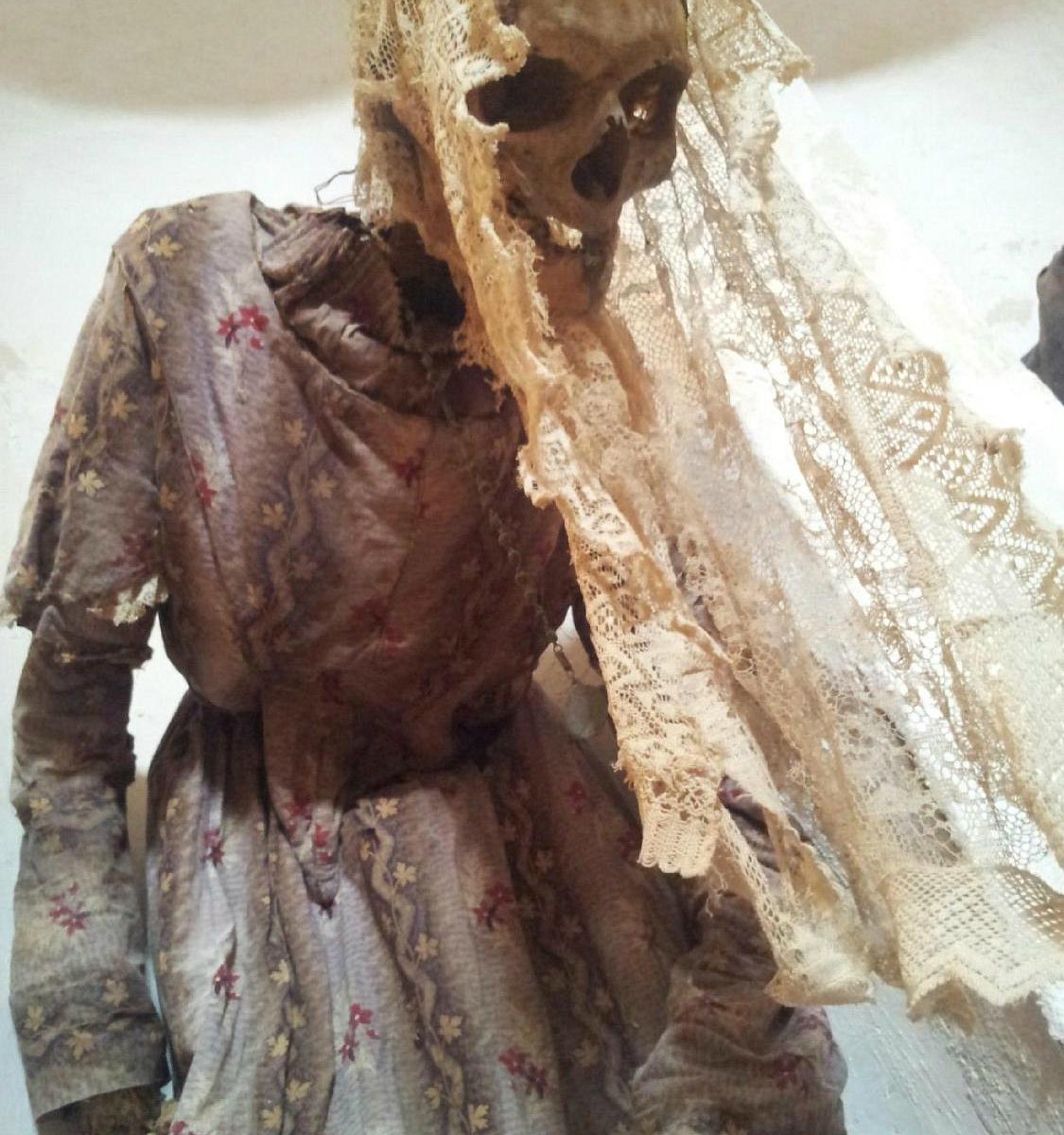
“I was so excited when I found these items. To think that the last person who touched them lived almost two thousand years ago and it shows some of the history of the island”.
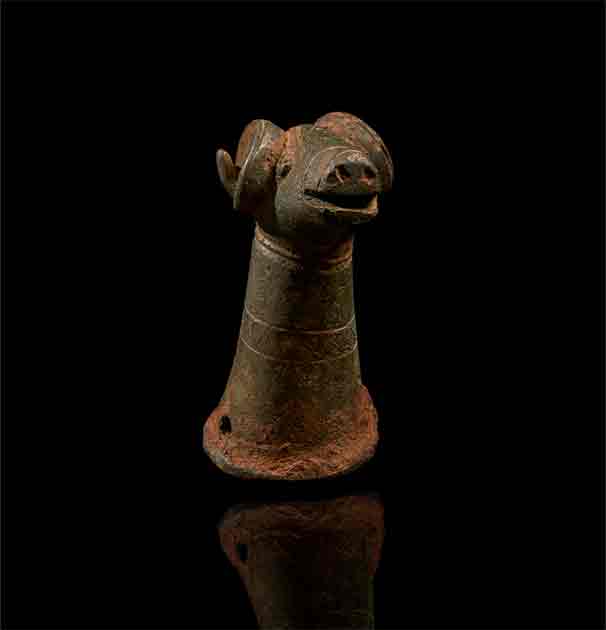
Iron Ram’s head. (Museum Wales)
The Anglesey Druids Last Stand
The Isle of Anglesey, known to the Romans as Mona, has long been enveloped in tales of savagery and mysticism, primarily centered around its ancient Druid inhabitants. Historically depicted as the last bastion of paganism in Wales, the island’s conquest in 77 AD by the Romans is often cited as the end of ‘barbaric’ Druidic practices. But recent discussions among historians suggest that this image of bloodthirsty Druids may have been a Roman exaggeration, propaganda to justify the brutal colonization of the British Isles.
Located off the northwest coast of Wales and bordered by the Irish Sea, Anglesey’s fertile valleys and strategic location made it an essential agricultural center and a stronghold of Druidic culture. This island, rich in megalithic burial chambers and standing stones, provides tangible evidence of its significant Neolithic and early Bronze Age presence. By 100 BC, Celtic traditions had firmly taken root, culminating in Anglesey’s evolution into a revered Druidic sanctuary.
The Roman perspective, largely derived from accounts such as those of Julius Caesar following his 55 BC encounter, and Tacitus, paints Druidism in a dark light, highlighting practices like human sacrifice as abhorrent. However, these accounts are increasingly scrutinized for their potential bias and the possibility that they were part of a larger narrative strategy employed by the Romans to demonize the Druids, thereby legitimizing their own military campaigns.
The Romans’ eventual suppression of Druidism on Anglesey marked a significant cultural shift, but the true nature and practices of the Druids remain a subject of debate. This reevaluation invites a deeper understanding of the clash between Roman imperialism and the indigenous cultures of the British Isles, challenging long-held perceptions and opening new avenues for historical research. As scholars continue to unearth and interpret evidence, the story of Anglesey and its Druids is far from closed, suggesting that what has been accepted as historical fact may, in truth, be a complex tapestry woven from narratives of conquest and resistance.
Roman Offerings Signifying the End of the Druids
Adam Gwilt, Principal Curator for Prehistory at Amgueddfa Cymru – Museum Wales said:
“This culturally mixed artifact group, containing both Iron Age chariot fittings and Roman cavalry fittings, is an important new find for the island. It was placed during or in the aftermath of the period of invasion of the island by the Roman army. This dramatic event is vividly captured by the Roman author Tacitus, writing about the strange first encounter between Roman soldiers and Druids on Anglesey. This group of gifted objects illustrates how watery locations, including the sacred lake site at Llyn Cerrig Bach, were seen as significant places for religious ceremony at this time of conflict and change.
The ram’s head fitting, probably a vehicle-fitting or staff-head is decorated in the late Celtic art style. It is a closely observed and quirky depiction of the ram and a likely future ‘star’ exhibit loved by many for Oriel Môn!”
Ian Jones, Building and Collections Manager at Oriel Môn, said:
“Since the discovery of the Iron Age artifacts from Llyn Cerrig Bach during the 1940s, Anglesey has long been associated with this important period in our history. This exciting new find from the island will enhance our understanding and knowledge, and Oriel Môn is pleased to collaborate with Amgueddfa Cymru and is eager to acquire it for our collection. The items themselves and nature of how they were deposited are of immense archaeological significance and will provide us with a great deal of potential in terms of display and interpretation. It will also offer fantastic outreach and educational opportunities. We understand that items from this period are of interest to our visitors, so this is thrilling news for us all.”
Oriel Môn museum and arts center has expressed an interest in acquiring this artifact group for its collection after it has been independently valued by via the Treasure Valuation Committee.
This article is largely a news release by Amgueddfa Cymru (Museums Wales) titled, ‘Religious Spring Find from Anglesey Declared Treasure’. The section on Anglesey Druids has been added by an Ancient Origins Editor for historic context.
Top image: The collection of 16 mostly Roman offerings found at the sacred spring site in Anglesey. Source: Museum Wales


